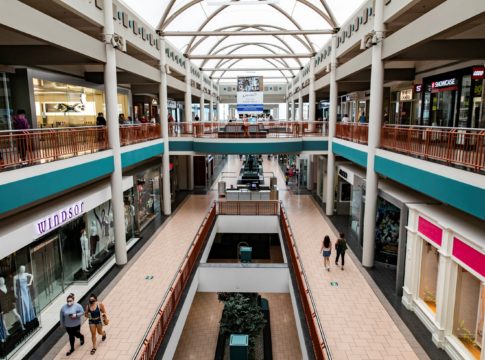Phillips Edison & Company (NASDAQ: PECO), one of the nation’s largest owners and operators of grocery-anchored shopping centers, today released its findings on the top shopping center trends taking shape in 2022 as part of ICSC Las Vegas.
Common themes driving this year’s trends are proximity and convenience, as retailers across all categories seek to gain easier access to their end consumers. This has led some retailers to evolve or shift their real estate strategies to focus on suburban expansion, meeting rising consumer demand as these areas continue to see strong population growth across the country.
“While cities are recovering from the pandemic, we’ve seen suburbanization as a theme continue to play out, supported by strong macro tailwinds including long-term work from home trends and an aging millennial cohort seeking space to raise their growing families,” said Mike Conway, Vice President of National Accounts and Retail Partnerships at PECO. “As inflation and supply chain issues continue to create obstacles, retailers are recognizing now more than ever the importance of locating closer to their end consumers, and this is driving many of the trends we’re seeing today.”
Healthcare providers – which had traditionally been located in medical office buildings and other non-retail properties – are among the most active within PECO’s portfolio, reflecting their desire to be even more conveniently and efficiently accessible for patients. Further, providers such as One Medical, Pacific Dental, Humana and Carbon Health have also recognized the opportunity to leverage open-air retail storefronts to create an even more comforting, welcoming environment and experience. The “medtail” trend demonstrates the appeal of community shopping centers owing to strong visibility, high foot traffic and the ability to open quickly and efficiently.
As it relates to convenience, a rising tide of quick-service restaurants including Scooters, Dutch Bros., PF Changs, Salad & Go, Krispy Kreme, Popeyes and Jimmy Johns are introducing no dine-in and drive-thru-only locations, reflecting strong grab-and-go trends that arose during the pandemic. Built to integrate with mobile ordering and other technologies, these concepts show how innovative brands are rapidly adapting to shifting consumer preferences and diversifying their portfolios to provide consumers with more optionality. These digital-first locations also help to account for labor shortages, which continue to present significant challenges for restaurant operators.
Big-box retailers such as Petco, Target, Macy’s and Kohl’s, as well as mall-traditional tenants including Bath & Body Works, Visionworks and Pearle Vision, are introducing smaller-format stores in open-air shopping centers to bring them closer to their consumers. Traditionally, these retailers were most often located in power centers and larger malls and the proximity to shoppers was more distant. From these neighborhood centers, they are facilitating easier access for buy-online-pick-up-in-store and last-mile delivery, helping to mitigate some of the pressure stemming from persisting supply chain issues.
On the topic of environmental, social and governance (ESG), which investors and consumers alike continue to emphasize, a growing number of brands of all sizes are reaffirming their commitments to sustainability. Target and Amazon have both introduced sustainable stores that use less energy than they produce, while Walmart is creating a net zero store in Canada. In addition, UPS has announced its commitment to achieve carbon neutrality by 2050, Petco is aiming to increase sustainable pet products by 50 percent by 2025, and Williams-Sonoma has partnered with the Arbor Day Foundation to plant 6 million trees by 2023. The grocery chain Raley’s is also taking innovative steps forward, introducing new technologies and strategies to reduce its carbon footprint, including waste stream reduction, increased recycling and reducing the use of micro-plastics.
PECO also noted that retailers are becoming increasingly creative with their use of technology. Grocery chains H-E-B and Albertson’s have found success generating sales through the use of Facebook’s Live Shopping feature, where consumers can watch a live stream demo on the social media platform and purchase the products being used directly within the video. Moreover, following its acquisition of virtual fitting room platform Zeekit last year, Walmart recently announced that the technology is now available to its shoppers, making online shopping even easier.
“The world has changed so rapidly over the last two years, and yet we’ve continued to see from retailers a level of creativity, innovation and adaptation that further demonstrates their ability to evolve with the times and give consumers more of what they want,” said Ashley Casey, Senior Director of National Accounts at PECO. “One of the areas that will be interesting to watch over the next few years is how retailers integrate Web3 and the metaverse into their omnichannel strategies. We’ve already seen companies like Adidas and Gap introduce NFTs, while Panda Express has filed a trademark for virtual goods, and Forever 21 has opened a virtual store. We are still in the very early days of this next iteration of the internet, and we’re excited to see how retailers make use of the technology.”
These insights are produced by PECO’s National Accounts and Emerging Trends team, which consists of a group of highly specialized leasing professionals that tracks over 400 accounts and actively engages with 150 growing retailers. This team travels the country meeting with brands to learn how they are evolving to identify creative ways that PECO can advance their real estate objectives. In the process, the team closely tracks and documents developing trends across different retail categories including grocery, restaurant, fitness, health and beauty, medical, entertainment and discount.
This deliberate information gathering approach has proved extremely beneficial to PECO since the team was formed in 2016. This focus leads to collecting a copious amount of data that is constantly informing the company’s leasing strategies as well as how, where and when it chooses to deploy capital. The team’s efforts have resulted in new and stronger relationships with a wide range of innovative retailers that are redefining the retail landscape and customer experiences.





